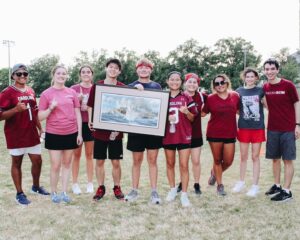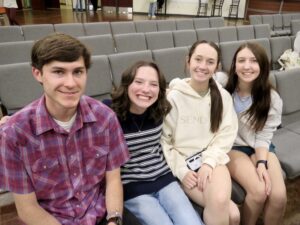A TV commercial a few years back featured an obviously affluent couple meeting with a prestigious architect. When the architect asked, “And what can I do for you?”, the wife pulled out from a bag a sleek bathroom sink faucet. “We want you to design a house around THIS.” The architect raised his eyebrow in fascination.
Sometimes inspiration comes from exposure to a steady diet of experiences or ideas, and sometimes it can come from a simple faucet. Such was my own experience upon being exposed to Sam Van Eman’s book, Disruptive Discipleship: The Power of Breaking Routine to Kickstart Your Faith (IVP, 2017), initially via an interview on the Collegiate Collective website. Sam, a campus minister with Coalition for Christian Outreach (CCO), has a specialty ministry in which he takes students on challenging experiences, from backpacking in the Colorado Rockies to “Survival”-like adventures in other countries. Taking students on such experiences is not in itself unique, but Sam designs these as intentional disciplemaking experiences, with regular questioning, probing, and feedback, in which pushing students beyond their normal boundaries can provide contexts for spiritual transformation.
Sam creates discipleship experiences which are planned and often high intensity. This got me thinking: If you can have planned and high intensity discipleship experiences, then what about unplanned and low intensity discipleship experiences? Which led to this simple 2 X 2 grid:
| Planned | Unplanned | |
| Low Intensity | ||
| High Intensity |
I am thinking of “planned” as referring to anything that is scheduled, such as a study group or an event. “Unplanned” are the things that happen apart from a schedule. “Low intensity” refers to experiences that normally don’t require deep vulnerability or discomfort, whereas “high intensity” experiences definitely do.
In his final words to the eleven remaining disciples, Jesus gave this command: “All authority in heaven and on earth has been given to me. Therefore, go and make disciples of all nations…” (Mt. 28: 18-19) The command was clear, but how were his disciples then to fulfill this command? By following the examples Jesus himself lived out before them, of course. Given that, it will be important to see how this grid might reflect methods Jesus himself used in helping those closest to him become deeply committed followers for life.
So, let’s explore this grid and see if it can be a helpful tool in evaluating our discipleship methods.
Quadrant One: Low Intensity/Planned Discipleship
| Planned | Unplanned | |
| Low Intensity | Teaching | |
| High Intensity |
Key expression: Teaching
In Mark 4:34 we read, “But when he was alone with his own disciples, he explained everything.” Jesus definitely chose downtimes from the busyness of normal life to teach his disciples what they needed to hear.
In following Jesus’ example, for us this might be the regularly scheduled discipleship group, a study group, a Sunday School class, or any group following an intentional plan or curriculum for leading participants over time through key concepts one needs to know to be a deeply committed follower of Jesus. Or it could be a one-on-one experience, meeting in a home, a coffeehouse, or even in the workplace.
A leader shares what he or she knows about being a disciple through some form of teaching. This teaching is planned, but also low intensity, in such a way that doesn’t provide too much disruption or stress. And a high focus on content and passing that content along in a way that encourages the participants to incorporate what they’re learning into their lives.
Some leaders might respond that when people are under the teaching of the Word of God it can be a high intensity experience, as God convicts us of error and sin or we wrestle with some new insight and come to terms with changes we need to make. Of course. We teach others the truths of God as a primary way of helping them grow, and this approach can produce high impact. However, in these discipleship moments, the learner is often a passive consumer of information rather than a participant in ministry. If you contrast this context with that of the higher intensity experiences in quadrants three and four as I’ll explain later, I think the difference is clear.
I think this covers probably 90% of what most would think of when they think of an intentional discipleship process. It is the tried and true method–an intentional, planned approach helps disciples learn and grow. But there are other ways to help people grow in their walk with God. Which leads to the next quadrant:
Quadrant Two: Low Intensity and Unplanned Discipleship
| Planned | Unplanned | |
| Low Intensity | Teaching | Modeling |
| High Intensity |
Key expression: Modeling
The obvious example from the life of Jesus was his calling and gathering of the twelve disciples into an intentional community to do life together over three years. Mark 3:13-15 says:
Jesus went up on a mountainside and called to him those he wanted, and they came to him. He appointed twelve that they might be with him and that he might send them out to preach and to have authority to drive out demons.
Beyond the planned small group way of discipleship, there’s another way that involves what some call “life on life” discipleship. In this approach, discipleship is not so much taught as caught, as the disciplemaker invites another into his or her regular flow of life and models what a follower of Jesus looks like in everyday life. Because you’re doing life together it’s definitely not a structured, planned approach, but it is absolutely intentional and purposeful.
Max Barnett was the long-time Baptist Campus Minister at the University of Oklahoma and a master disciplemaker. I’ve heard stories about how Max took a number of young men over the years and helped them grow into maturing, multiplying disciples themselves by practicing, in addition to more structured methods, this “life on life” approach. I know many campus ministers who have followed Max’s example and have a regular practice of inviting a student to shadow them throughout their daily lives.
This doesn’t have to happen over a long span of time. When I traveled to New Mexico as a teenager to serve as a summer missionary I arrived a week earlier than the others who would serve on our team. During that week I worked alongside the missionary helping to overhaul a carburetor on the bus we would use that summer, along with many other tasks. As we worked together, Bill Rutledge talked at length about what it meant to serve among people of a different culture than one’s own, how I was not to insert my own culture into the local culture, and how the gospel could be communicated across cultures. (I also learned how to
repair a carburetor!) It was only one week 40 years ago but hanging with Bill for that week was the best “Missions 101” training I could ever receive. Much of what he passed along to me between the wrenches and hammers was definitely “caught,” and became part of the missional DNA of my life going forward.
Those are the low intensity quadrants. Let’s move on now to the high intensity areas.
Quadrant Three: High Intensity and Planned Discipleship
| Planned | Unplanned | |
| Low Intensity | Teaching | Modeling |
| High Intensity | Experiencing |
Key expression: Experiencing
In Mark 6:6-13 we read a more expanded version of what we saw in the previous passage, where in addition to being with Jesus, his disciples were sent out on specific missions to the surrounding communities:
Then Jesus went around teaching from village to village. Calling the Twelve to him, he began to send them out two by two and gave them authority over impure spirits. These were his instructions: “Take nothing for the journey except for a staff–no bread, no bag, no money in your belts. Wear sandals but not an extra shirt. Whenever you enter a house, stay there until you leave that town. And if any place will not welcome you or listen to you, leave that place and shake the dust off your feet as a testimony against them.” They went out and preached that people should repent. They drove out many demons and anointed many sick people with oil and healed them.
Notice here how Jesus designed these sending experiences to be as challenging and disruptive as possible. There was a mission purpose to these experiences, for sure, but along with that it is clear that Jesus wanted his disciples to be challenged in ways that would lead to growth and transformation. Knowing that his disciples would be the primary ones carrying forth his message after his ascension, Jesus was absolutely preparing them for the work that was to come.
We now arrive at the quadrant that inspired this entire post, the planned, high intensity quadrant of “disruptive discipleship.” Mission trips, service trips, plunges and the like–these are the activities that get us out of our normal mode of operations and throw us off balance. However, they don’t have to involve a getaway. Let’s hear from our friend Sam:
We believe Jesus can use any shift to transform his people. So designed experiences include signing up for a marathon, donating all but a week’s worth of clothing (and committing not to replace what you gave away), agreeing to mentor a young professional or newly married couple, or unplugging a favorite streaming service. The list is endless, really. As long as it causes a bit of anxiety in anticipation of being shooed from the nest, we see results.
–Disruptive Discipleship, p. 5
(As one who trained for and actually finished a marathon, I can attest that was definitely a “disruptive” experience!)
The point here is not simply that one be stretched, but again, that an intentional experience– under the guidance of a wise and mature leader–can be used of God to transform us in the quest for spiritual maturity.
And just to be clear, the planned part of this quadrant is on the front end of the experience. What a participant actually experiences in a real way cannot be anticipated, as God will stretch each one according to what he or she needs. Again, the role of a wise and mature leader who helps the disciple process and learn from the experience cannot be overstated. And as we grow from our mistakes and failures as much or more than we do from our successes, I offer this meme from my LinkedIn page: “As long as we have teachable hearts and minds, nothing we experience can be considered a failure or a waste of time.”
Quadrant Four: High Intensity and Unplanned Discipleship
| Planned | Unplanned | |
| Low Intensity | Teaching | Modeling |
| High Intensity | Experiencing | Responding |
Key expression: Responding
In Mark 6:30-44, The disciples were confronted with an enormous crowd that had traveled to a remote location to hear Jesus, and who were now hungry at the end of a long day. The twelve were distressed with the situation and wanted to send the people away to find food. But they were really distressed when Jesus told them to feed the crowd. Jesus turned this unplanned, definitely high intensity experience into a teachable moment for his disciples. Although his follow through with them is not recorded, there can be no doubt that Jesus and the twelve spent some quality time unpacking this event. It was a major opportunity for their faith to grow.
This quadrant speaks to intentionally responding to and being present in the midst of major life challenges. When we are present, we can help those we are discipling to unpack and understand how God can use those challenges to shape their lives.
Things happen. People get sick, tragedies occur, things don’t work out the way we hope, and disappointment follows. We usually see such contexts in light of emergency response and crisis care. Of course. But they can absolutely be vehicles for radical growth in faith. When we are intentionally present in the lives of those with whom we have been discipling when things fall apart, it can be an opportunity for major growth steps in one’s walk with God.
We’re all familiar with the concept of “teachable moments.” When a crisis occurs, a person may be more open to change than they would be when everything is going well. So how can we know when it is appropriate to bring up a teachable moment when someone is going through a crisis?
In the early 2000s Rick Richardson, then with InterVarsity, identified five major shifts that were impacting culture. One of these, “Identification before Influence,” addressed the reality that in order to influence young adults, we needed to do so from a posture of personal identification with their struggles and not from a posture of authority. This is so true. In this quadrant there is tremendous opportunity for influence, but we must be careful here not to overplay our hand; if we try to insert ourselves beyond what is appropriate it could be harmful. This quadrant, perhaps more than any of the four, requires careful sensitivity and prayerful dependence upon the Spirit of God.
In preparing this post, I ran it by Robbie Nutter, Director of Christian Challenge at Kansas State University. Robbie offered a valuable insight on this point: “If we don’t do Quadrant Two (life on life), Quadrant Four (being present) has no power. A well-invested Two can give Four transformational power” Again, so very true.
Some unplanned, high intensity experiences will not be the result of a personal crisis but represent a teachable moment, nonetheless. Such was the experience of the disciples in the story of the feeding of the 5000. Jesus took advantage of this as a teachable moment, and as we are sensitive to the leading of the Spirit throughout the experiences of life, we can as well.
An Important Reminder
You’ve probably noticed a common factor in all four of these quadrants: intentionality. When we are intentional, we are able to see all arenas of life as opportunities for making disciples.
Back to Sam Van Eman and Disruptive Discipleship. At the end of his book, Sam points out that for those of us who are intentional regarding our discipleship processes, it is tempting to think the transformation is dependent on our initiative. But we need to be reminded that it is God who’s in charge, and we are witnesses to his work of transformation. We observe what God is doing, we pay attention, and respond accordingly:
This is why paying attention had to become more important to me than taking charge. By witnessing what God is up to, we become co-unfolders. We attune ourselves to God, observe the situation at hand, and respond…We are not in charge of that growth. We are not able to transform others. But the transformational insight that’s revealed commissions us to invite others to be transformed.
–Disruptive Discipleship, pp. 178-179
Closing Thoughts
The Discipleship Grid is a simple but powerful way of looking at your intentional discipleship strategy. The Grid is not itself a strategy, and it doesn’t address the content of your teaching. Rather, it is a lens, a frame, a 4-D, 20,000-ft view to help you examine if your discipleship perspective takes into account the many arenas of life available for investing in a life for the Kingdom, of developing fully committed followers of Jesus.
Here in my context in Pennsylvania/South Jersey, we have identified and are embracing three behaviors that any church needs to practice in order to be healthy: Missional Engagement, Leadership Development, and Intentional Discipleship. It is my hope and prayer that this simple tool of the Discipleship Grid will be found useful in helping you, your church, or your campus ministry become a more intentional and effective disciplemaking entity.
The Discipleship Grid is a work in progress. I welcome and invite your feedback. I would love to hear how the four quadrants speak to you, hear your stories of how you are intentionally making disciples in each of the four quadrants, and invite your input related to anything you see here so that I can make this a better tool. I hope Version 2.0 will have lots of your stories and suggestions included. You can e-mail me at [email protected]







 by
by